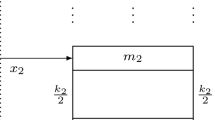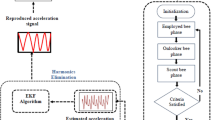Abstract
In this paper, a Cochlea-inspired Artificial Filter Bank (CAFB) was developed in order to efficiently acquire dynamic response of structure, and it was also evaluated via dynamic response experiments. To sort out signals containing significant modal information from all the dynamic responses of structure, it was made to adopt a Band-pass filter Optimizing Algorithm (BOA) and a Peak-Picking Algorithm (PPA). Optimally designed on the basis of Kobe earthquake signals, it was then embedded into the Wireless Variety Measurement System (WiVMS). In order to evaluate the performance of the developed CAFB, a vibration test was conducted using the Kobe earthquake signals, and structural responses of a two-span bridge were obtained and analyzed simultaneously by both a wired measurement system and a CAFB-based WiVMS. The test results showed that the compressed dynamic responses acquired by the CAFB-based WiVMS matched with those of the wired system, and they included significant modal information of the two-span bridge. Therefore this study showed that the developed CAFB could be used as a new, economic, and efficient measurement device for Wireless Sensor Networks (WSNs) based real time structural health monitoring because it could reconstruct the whole dynamic response using the compressed dynamic response with significant modal information
Similar content being viewed by others
References
Abe, M. and Fujino, Y. (2009). Bridge monitoring in Japan, Encyclopedia of Structural Health Monitoring, 5, John Wiley and Sons.
Aktan, A. E, Catbas, F. N., Grimmelsman, K. A., and Pervizpour, M. (2003). Development of a model health monitoring guide for major bridges, Drexel Intelligent Infrastructure and Transportation Safety Institute.
Farrar, C. R. (2001). Historical overview of structural health monitoring, Lecture notes on structural health monitoring using statistical pattern recognition, Los Alamos Dynamics, Los Alamos, USA.
Heo, G. and Jeon, J. (2009). “A Smart monitoring system based on ubiquitous computing technique for infra-structural system: Centering on identification of dynamic characteristics of self-anchored suspension bridge.” KSCE Journal of Civil Engineering, Vol. 13, No. 5, pp. 333–337, DOI: 10.1007/s12205-009-0333-z.
Jang, S., Jo, H., Mechitov, K., Rice, J. A., Sim, S. H., Jung, H. J., Yun, C. B., Spencer, Jr., B. F., and Agha, G. (2010). “Structural health monitoring of a cable-stayed bridge using smart sensor technology: Deployment and evaluation.” Smart Structures and System, Vol. 6, Nos. 5–6, pp. 439–459, DOI: 10.12989/sss.2010.6.5_6.439.
Katsuchi, H., Yamada, H., and Kusuhara, H. (2008). “Structural monitoring and design verification of akashi kaikyo bridge.” Proceedings of the 11 th International Conferenceon Engineering, Science, Construction, and Operations in Challenging Environments, pp. 1–8.
Ko, J. M. and Ni, Y. Q. (2003). “Structural health monitoring and intelligent vibration control of cable-supported bridge: Research and application.” KSEC Journal of Civil Engineering, Vol. 7, No. 6, pp. 701–716, DOI: 10.1007/BF02829139.
Ko, J. M. and Ni, Y. Q. (2005). “Technology developments in structural health monitoring of large-scale bridges.” Engineering Structures, Vol. 27, pp. 1715–1725.
Koh, H. M., Lee, H. S., Kim, S., and Choo, J. F. (2009). Monitoring of bridge in Korea, Encyclopedia of Structural Health Monitoring, 5, John Wiley and Sons.
Lynch, P. J. (2007). “An overview of wireless structural health monitoring for civil structures.” Philosophical Transactions of the Royal Society A, Vol. 365, pp. 345–372.
Park, J. C., Park, C. M., Kim, B. H., Lee, I. I., and Cho, B. W. (2006). “Dynamic characteristics of seohae cable-stayed bridge based on long-term measurements.” Journal of Earthquake Engineering Society of Korea, Vol. 10, No. 6, pp. 115–123, DOI: 10.5000/EESK.2006.10.6.115.
Peckens, C. A. and Lynch, J. P. (2013). “Utilizing the cochlea as a bioinspired compressive sensing technique.” Smart Materials and Structures, Vol. 22, No. 10, pp. 105027.
Peckens, C. A., Lynch, J. P., and Heo, G. (2015). “Resource-efficient wireless sensor network architecture based on bio-mimicry of the mammalian auditory system.” Intelligent Material Systems and Structures, Vol. 26, No. 1, pp. 79–100, DOI: 10.1177/1045389X14521877.
Peeters, B., Couvreur, G., Razinkov, O., and Kundig, C. (2003). “Continuous monitoring of the oresund bridge: System and data analysis.” Proceedings of IMAC 21, International Modal Analysis Conference, Kissimmee, Florida, USA.
Sohn, H., Farrar, R., Hemez, H., and Czarnecki, J. (2002). A review of structural health monitoring literature: 1996-2001, Los Alamos National Laboratory.
Wong, K. Y. (2004). “Instrumentation and health monitoring of cablesupported bridge.” Structural Control and Health Monitoring, Vol. 11, pp. 91–124, DOI: 10.1002/stc.33.
Author information
Authors and Affiliations
Corresponding author
Rights and permissions
About this article
Cite this article
Heo, G., Jeon, J. Development of a Cochlea-inspired Artificial Filter Bank (CAFB) and evaluation of its performance via real-time dynamic response tests on a two-span bridge. KSCE J Civ Eng 20, 777–783 (2016). https://doi.org/10.1007/s12205-015-0379-z
Received:
Accepted:
Published:
Issue Date:
DOI: https://doi.org/10.1007/s12205-015-0379-z




